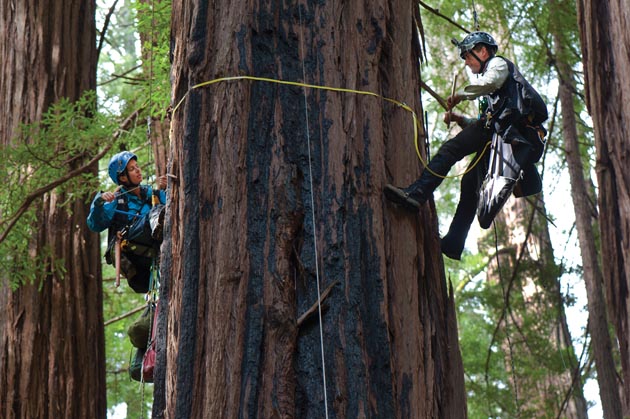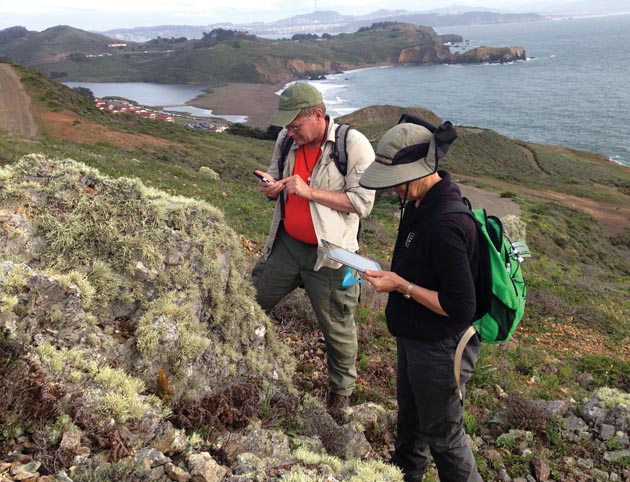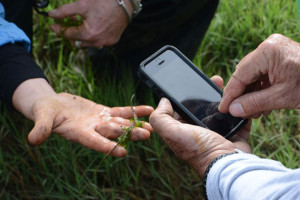On the last weekend of March, 9,000 people armed with binoculars, butterfly nets, cameras, and smartphones, spread out over an archipelago of national park lands from Point Reyes in Marin County to Mori Point on the San Mateo coast. Their goal: document as many species as possible of plants, animals, and other living things in the Golden Gate National Parks within a 24-hour period, noon Friday to noon Saturday. It was a bioblitz, an exercise in mass citizen science organized by the National Park Service and the National Geographic Society.
It’s not a perfect scientific environment, but whatever it lacks in rigor or thoroughness it makes up for in quantity, with bioblitzers recording almost 10,000 individual observations during the event. And indeed, the goal of the event was as much to engage people with nearby nature as it was to thoroughly catalog it.
But plenty of cataloging was done. As of late April the tentative grand total according to National Geographic stood at 2,303 species: 986 single-celled organisms, 655 plants, 33 seaweeds, 111 fungi and lichens, 60 mollusks, 139 insects and arachnids, 17 fish, 19 reptiles and amphibians, 150 birds, 39 mammals, and 94 taxonomic odds and ends. The animals ran the gamut from freshwater sponge to mountain lion. A surprisingly high number of species—at least 80 —had never before been recorded in the Golden Gate National Parks. Fifteen—among them the Mission blue butterfly, the Presidio clarkia, and the San Francisco garter snake—are on federal and state lists of endangered and threatened species.
“It would be disingenuous to say this is robust science in the sense of rigorous questions and answers,” says John Francis, National Geographic’s vice president for research, conservation, and exploration. “But it provides a valuable baseline. The record will be useful generations from now.”

To get a taste of this increasingly popular exercise in citizen science, I joined two inventories at the Presidio in San Francisco. Friday’s event focused on the wildflowers of Lobos Dunes. Brianna Schaefer, who manages the Presidio’s native plant nursery, led a small group from Baker Beach up along Lobos Creek and into the dunes. At least 130 native plants have been documented at this site, where restoration began in 1995. It was a balmy afternoon, with the massed blooms of silvery lupine scenting the air. Following a boardwalk, we crossed paths with several parties of grade-schoolers, a few of the 2,700 students participating in the bioblitz, whose excitement almost drowned out the singing mockingbirds.
The dune plants were a mix of residual and reintroduced. Schaefer showed us a patch of creamy-white San Francisco wallflowers and other local specialties. She pointed out the saw-toothed gray-green leaves of the endangered San Francisco lessingia, a sunflower relative that had a moment of notoriety in 2002 when a newspaper columnist attacked it as a useless weed. We were too early for its yellow flowers. “Working at the nursery, you learn to recognize everything when it’s not flowering,” Schaefer said. Like all the group leaders, she used the iNaturalist smartphone app to record significant finds.
Along the way, we encountered local butterfly expert Liam O’Brien, whose group searching for butterflies and moths had just added a new species to the Presidio’s fauna record: a fiery orange Gulf fritillary. Larval Gulf fritillaries eat only passion vine leaves; years ago, the butterfly followed passion vine plantings into the western United States.
I had been warned that nature happens, rain or shine. Saturday morning was shineless: a frog-strangler of a rainstorm. Tori Seher, a national park biologist based on Alcatraz, met 11 undaunted volunteers at Crissy Field for a bird census. As we squelched toward the restored lagoon, she coached the group’s novices on the field marks of ducks and grebes. We spotted a couple of shorebirds, loons, a sparrow or two, a lone barn swallow. But it was hard to see plumage details through rain-blurred binoculars, and our ranks thinned rapidly. Good weather for waterbirds, maybe; less so for observers.
You can look at the 114-year-old Audubon Society Christmas Bird Count as the prototype of the bioblitz, and of grassroots citizen science in general. But including every life-form dates only to 1996. National Park Service biologist Susan Rudy, who organized a pioneering survey at Kenilworth Aquatic Gardens in Washington, D.C. in 1996, is credited with coining the term. The concept has since gone global, with bioblitzes from Ireland to New Zealand. Locally, the grassroots group Nerds for Nature has blitzed Lake Merritt, the Palo Alto Baylands, Sunol Regional Park, and Tilden Regional Park, all within the last few months.
The bioblitz partnership between National Geographic and the National Park Service started in 2007 in Washington’s Rock Creek Park. That inaugurated the current series of annual events in national parks from Biscayne Bay to the Colorado Rockies, the Lousiana bayous, and the Sonoran Desert. (Next up: Hawaii Volcanoes National Park.) The series was expected to end in 2016, coinciding with the Park Service’s centennial, but now there’s talk of extending it.
These National Geographic–National Park Service bioblitzes are the Super Bowls of bioblitzing, given their scale and the presence of scientific celebrities: Marine biologist Sylvia Earle led a beach walk at the Marin Headlands while in Muir Woods, Humboldt State University botanist Steve Sillett—profiled in Richard Preston’s book The Wild Trees—ascended a redwood in search of whatever might be living in the canopy. Sillett and his Humboldt State colleague Marie Antoine found more than 40 lichen species living on the trunk and branches of one 250-foot-tall redwood (including one, Loxosporopsis corralifera, never found this far south before); nearby, UC Berkeley researchers Rikke Reese Næsborg and Cameron Williams found 57 lichen species and an arboreal salamander on a 230-foot-tall Douglas fir.
A few scientists and amateur naturalists follow the national park bioblitzes around the country. Gary Hevel of the Smithsonian drove out from Silver Spring, Maryland, to collect 150 insect species, including a dozen kinds of parasitic wasp, at Crissy Field. Randy Miller, a professor at Baker College in Michigan, was after tardigrades, small but near-indestructible invertebrates also known as water bears. Four years ago, Miller discovered a new tardigrade species in a barnacle growing on a mangrove log in Biscayne National Park. He was hoping something interesting would turn up in Sillett’s moss and lichen samples from the top of the redwoods. “The appeal is access to the National Parks with a valid collecting permit,” he said. “And it gets me to places I might not otherwise get to in my lifetime.”
The Golden Gate BioBlitz 2014 was the largest one to date, with some 320 Northern California scientists—from UC Davis, UC Berkeley, and other schools, as well as the California Academy of Sciences—and informed amateurs recruited to lead 161 separate outings over the 24-hour period.
Despite Saturday’s inclement weather, the San Francisco bioblitz broke previous records for numbers of participants, students, scientists, and species counted. But it wasn’t just about the numbers. “We all came away with a renewed appreciation for the amazing biodiversity of our national parklands, and for the engaged community in which we live that supports the national parks on our doorsteps,” says Golden Gate National Parks Conservancy president Greg Moore.
For National Park Service public affairs specialist Alexandra Picavet, the event was “successful on many fronts. We created new relationships with the community and diverse audiences, and we got to know more about our park.”
Bioblitzes are joint ventures in scientific research and public education. “The contribution to science is in the discovery of species, the confirmation of diversity patterns,” Miller says. “The biggest contribution is public education, with the hundreds of people who get a look at how we conduct research.”
Hevel agrees: “I see these outings as mostly educational. However, science improves with each one because of the records.”
National Geographic Society’s Francis notes that all the national park sites have been chosen for their proximity to metropolitan areas, as a way of helping city kids connect with the natural world. For example, some students from the Los Angeles area had never waded in the Pacific before a recent Santa Monica Mountains National Recreation Area bioblitz.
Ten thousand observations is plenty to keep a naturalist occupied. But for some of the younger participants, the bioblitz may have served as a gateway drug for the natural world.





